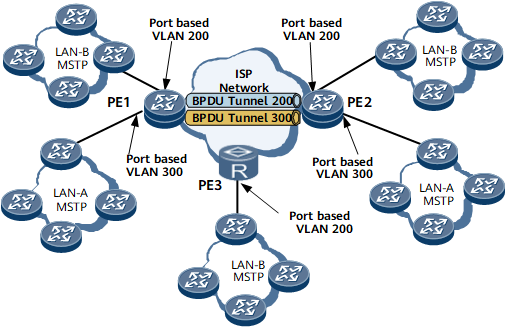Untagged Layer 2 Protocol Tunneling Application
When each edge device interface on a backbone network connects to only one user network and Layer 2 protocol data units (PDUs) from the user networks do not carry VLAN tags, configure untagged Layer 2 protocol tunneling to allow the Layer 2 PDUs from the user networks to be tunneled across the backbone network. Layer 2 PDUs from the user networks then travel through different Layer 2 tunnels to reach the destinations to perform Layer 2 protocol calculation.
In Figure 1, PEs on the backbone network edge must tunnel Layer 2 PDUs from the user networks across the backbone network.
PE1, PE2, and PE3 constitute a backbone network and use different interfaces to connect to LAN-A and LAN-B. Layer 2 PDUs from user networks to PEs on the backbone network do not carry VLAN tags. The PEs, however, must identify which LAN the Layer 2 PDUs come from. Layer 2 PDUs from a user network in LAN-A must be sent to the other user networks in LAN-A, but not to the user networks in LAN-B. In addition, Layer 2 PDUs cannot be processed by PEs. To meet the preceding requirements, configure interface-based Layer 2 protocol tunneling on backbone network edge devices. Multiple Spanning Tree Protocol (MSTP) runs on the LANs.
To tunnel Layer 2 PDUs from the user network across the backbone network, configure untagged Layer 2 protocol tunneling on user-side interfaces on PE1, PE2, and PE3.
The Layer 2 protocol tunneling process is as follows:
PE1 identifies the protocol type of the Layer 2 PDUs and tags the Layer 2 PDUs with the default VLAN ID of the interface that has received the Layer 2 PDUs.
PE1 replaces the multicast destination MAC address in the Layer 2 PDUs with a specified multicast MAC address based on the configured mapping between the multicast destination MAC address and the specified multicast MAC address.
The internal devices on the backbone network forward the Layer 2 PDUs with a specified multicast MAC address to the egress devices.
The egress devices PE2 and PE3 restore the original destination MAC address in the Layer 2 PDUs based on the configured mapping between the multicast destination MAC address and the specified multicast address and send the Layer 2 PDUs to the user networks. The Layer 2 PDUs are transparently transmitted.
